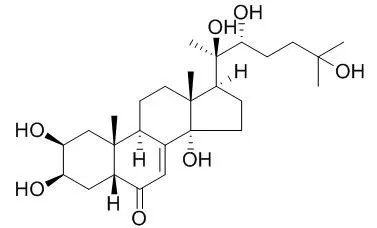| Kinase Assay: |
| J Biol Chem. 2015 Mar 27;290(13):8469-81. | | The steroid hormone 20-hydroxyecdysone via nongenomic pathway activates Ca2+/calmodulin-dependent protein kinase II to regulate gene expression.[Pubmed: 25670853 ] | The steroid hormone 20-Hydroxyecdysone (20E) triggers calcium signaling pathway to regulate 20E response gene expression, but the mechanism underlying this process remains unclear.
METHODS AND RESULTS:
We propose that the 20E-induced phosphorylation of Ca(2+)/calmodulin-dependent protein kinase II (CaMKII) serves an important function in 20E response gene transcription in the lepidopteran insect Helicoverpa armigera. CaMKII showed increased expression and phosphorylation during metamorphosis. 20E elevated CaMKII phosphorylation. However, the G protein-coupled receptor (GPCR) and ryanodine receptor inhibitor suramin, the phospholipase C inhibitor U73122, and the inositol 1,4,5-triphosphate receptor inhibitor xestospongin C suppressed 20E-induced CaMKII phosphorylation. Two ecdysone-responsible GPCRs and Gαq protein were involved in 20E-induced CaMKII phosphorylation by RNA interference analysis. 20E regulated CaMKII threonine phosphorylation at amino acid 290, thereby inducing CaMKII nuclear translocation. CaMKII knockdown by dsCaMKII injection into the larvae prevented the occurrence of larval-pupal transition and suppressed 20E response gene expression. CaMKII phosphorylation and nuclear translocation maintained USP1 lysine acetylation at amino acid 303 by inducing histone deacetylase 3 phosphorylation and nuclear export. The lysine acetylation of USP1 was necessary for the interaction of USP1 with EcRB1 and their binding to the ecdysone response element.
CONCLUSIONS:
Results suggest that 20E (via GPCR activation and calcium signaling) activates CaMKII phosphorylation and nuclear translocation, which regulate USP1 lysine acetylation to form an EcRB1-USP1 complex for 20E response gene transcription. | | J Insect Physiol. 2010 Oct;56(10):1436-44. | | Transcriptional regulation of the insulin signaling pathway genes by starvation and 20-hydroxyecdysone in the Bombyx fat body.[Pubmed: 20197069 ] | Genetic studies in the fruitfly, Drosophila melanogaster, have uncovered a conserved insulin/insulin growth factor signaling (IIS) pathway that regulates nutrition-dependent growth rates of insects.
METHODS AND RESULTS:
From the silkworm, Bombyx mori, we have identified and characterized several key genes involved in the IIS pathway, including InR, IRS, PI3K110, PI3K60, PTEN, PDK, and Akt. Tissue distribution analysis showed that most of these genes were highly expressed in the fat body implying that the IIS pathway is functionally important within insect adipose tissue. Developmental profile studies revealed that the expression levels of InR, IRS, PI3K110, and PDK were elevated in the fat body during molting and pupation, periods when animals ceased feeding and hemolymph levels of 20-Hydroxyecdysone (20E) were high. Starvation rapidly up-regulated the mRNA levels of these same genes in the fat body, while 20E slowly induced their transcription.
CONCLUSIONS:
We conclude that 20E slowly reduces food consumption and then indirectly induces a state of starvation resulting in the elevation of the mRNA levels of InR, IRS, PI3K110, and PDK in the Bombyx fat body during molting and pupation. |
|






 Cell. 2018 Jan 11;172(1-2):249-261.e12. doi: 10.1016/j.cell.2017.12.019.IF=36.216(2019)
Cell. 2018 Jan 11;172(1-2):249-261.e12. doi: 10.1016/j.cell.2017.12.019.IF=36.216(2019) Cell Metab. 2020 Mar 3;31(3):534-548.e5. doi: 10.1016/j.cmet.2020.01.002.IF=22.415(2019)
Cell Metab. 2020 Mar 3;31(3):534-548.e5. doi: 10.1016/j.cmet.2020.01.002.IF=22.415(2019) Mol Cell. 2017 Nov 16;68(4):673-685.e6. doi: 10.1016/j.molcel.2017.10.022.IF=14.548(2019)
Mol Cell. 2017 Nov 16;68(4):673-685.e6. doi: 10.1016/j.molcel.2017.10.022.IF=14.548(2019)